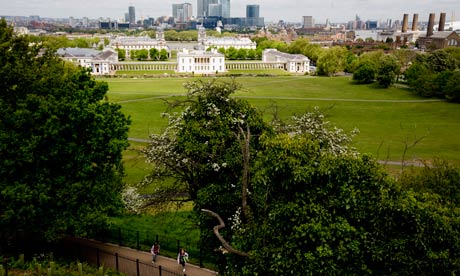
Visitors to London, as well as many of those who actually live in the city, tend to assume that it has little to offer in the way of historical remains much earlier than the Tower of London or Westminster Abbey, both of which are about a thousand years old. But London's history goes back a lot further than that. Indeed, the Tower of London is a mere youngster compared with the oldest manmade structure in central London, which predates the Tower by an astonishing 5,000 years. Before we look at this extraordinary relic, here are a few other places in London which were already ancient when William the Conqueror began building his fortress.
Just over a mile from the Tower, tucked away in a quiet courtyard at the end of Fleet Street, is the church of St Bride (stbrides.com/history). Some time in the sixth century, early Christians built a church on this spot over a sacred well dedicated to Brigit, a Celtic fertility goddess. Appropriating pagan places of worship in this way was common practice among the early Christians in London. Before the building of the church, women who wished to become pregnant would come to the well and leave some token offering to Brigit.
Not only did the Christians commandeer the holy places of the Celts, but they also took over their gods and festivals. Brigit became transformed into St Bride, and the Celtic spring festival of Imbolc, which was once celebrated on 1 February, became St Bride's day. In the crypt beneath the church can be seen the remains of a second-century structure, possibly a Romano-Celtic temple associated with the holy well.
Thomas Rich, a local baker who worked near this church in the late 18th century, began making wedding cakes shaped like the spire of St Bride's church. These layered cakes are still popular at weddings today – a continuing link between Brigit's well and fertility and procreation.
Another curious survivor sits just across the road from Cannon Street station, back in the City. Set into the wall of an empty shop at 111 Cannon Street is an ornate iron grill; behind it stands an unremarkable lump of blackened and grimy limestone. This is the London Stone, and was used since at least the ninth century as a place to strike deals and swear oaths. Lord Mayors of London were sworn in here. It was venerated as being the very heart of London. When the rebel leader Jack Cade entered the city in 1450, his first act was to strike the London Stone with his staff as a symbol of his authority.
Some legends suggest that the stone is the remnant of an altar brought to this country by Brutus, the mythical Trojan founder of London. A more prosaic but far more plausible explanation emerged after the second world war. Excavations uncovered the Roman Governor's Palace (heritage-key.com), a three-and-a-half-acre complex which stood nearby. The London Stone is probably a remnant of this building, perhaps part of a gatepost, which explains its ancient association with power and authority. Time and again we find that old London legends have some factual basis of this sort.
St Bride's Well and the London Stone both date back some 2,000 years. But there is a site twice as old as either of these. Salisbury Plain is famous for being dotted with prehistoric tombs, mounds and religious structures such as Stonehenge. But Londoners need not travel to Wiltshire to see such a landscape. On a grassy plateau overlooking the Thames in Greenwich Park (royalparks.gov.uk/Greenwich-Park), just inside the Croom Hill gate, is an extraordinary sight. Low hillocks and shallow, saucer-like depressions in the ground show that this is actually a Bronze Age cemetery. Tourists heading for the Royal Observatory hurry past this remarkable location without a second glance. It is a remaining fragment of a vast ritual landscape which once covered a large part of London and stretched far into Kent.
The Bronze Age barrows at Greenwich are old, but they are not the most ancient ritual site to be found in London. In 2010, archaeologists took a closer look at a group of wooden posts jutting out of the Thames mud near Vauxhall Bridge. These posts, originally about the size of telegraph poles, can be seen at low tide in front of the MI6 building. They were found to be over 6,000 years old, making them by far the oldest structure ever found in London, erected thousands of years before the stones of Stonehenge were set into place.
It is thought that they may be part of a cult site, perhaps akin to North American totem poles, or a wooden Stonehenge. When archaeologists set up a tripod to survey the site, they were swooped upon by armed police. A member of the public had alerted them to the fact that a group of terrorists were about to launch a missile at the nearby MI6 headquarters!
London's history goes back far beyond the Norman Conquest or even the Roman invasion. The most ancient sites all have some religious and mythological significance and a combination of archaeology and folklore is often required to make sense of them. Archaeology may reveal the physical remains, but it is often only in ancient legends that their true significance is found.
When dozens of human skulls were unearthed in the bed of the Walbrook, a stream which once ran through the City of London, archaeologists were puzzled. Then somebody remembered that Geoffrey of Monmouth, the medieval chronicler who popularised the legend of King Arthur, had written of Roman soldiers being beheaded on these banksr. It is now thought that these skulls are indeed those of Roman soldiers, removed by Boudicca's forces during the sack of London and thrown into the Walbrook as votive offerings.
• Simon Webb's book, Unearthing London: The Ancient World Beneath the Metropolis, is out now (The History Press, £14.99). For more information on ancient London history, see museumoflondon.org.uk

